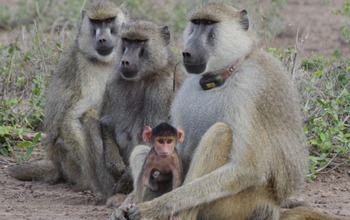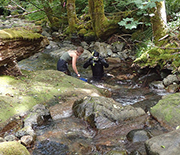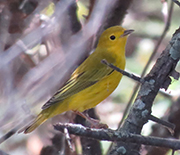News Release 18-085
NSF announces new awards for Understanding the Rules of Life
New projects address genetic, environmental causality in biological systems and processes

Kenyan baboons will be at the center of research studying mammalian gut microbiomes.
September 21, 2018
This material is available primarily for archival purposes. Telephone numbers or other contact information may be out of date; please see current contact information at media contacts.
The National Science Foundation (NSF) announced 29 awards in support of Understanding the Rules of Life, one of the agency's "10 Big Ideas for Future NSF Investments." The awards, totaling $15 million, demonstrate NSF's commitment to address some of the greatest challenges in understanding the living world, in all of its complex levels of organization, from the molecular scale through to the biosphere.
"These awards get to the heart of fundamental questions about biological processes that span multiple levels of organization," said Joanne Tornow, acting assistant director for NSF's Directorate for Biological Sciences. "We expect the science coming out of these awards to reveal new 'rules of life' that will contribute to a predictive understanding of living systems."
To better identify the "rules" for how life functions, researchers will develop better and newer research tools and infrastructure and establish a collaborative culture to train the next generation of researchers in cross-disciplinary scientific inquiry. NSF expects this research to establish certain "rules of life" that will enable forecasting or prediction of changes in biological systems.
Twenty of the newly awarded projects are funded through NSF's Early-concept Grants for Exploratory Research (EAGER) program and represent exploratory work in its early stages on untested but potentially transformative research ideas or approaches.
The other nine awards, funded through NSF's program for Research Advanced by Interdisciplinary Science and Engineering (RAISE), are bold, interdisciplinary projects whose scientific advances lie mostly outside the scope of a single discipline and appear to promise transformational advances.
As part of this same award solicitation, NSF also funded eight Understanding the Rules of Life-related workshops in 2018 aimed at complementing research in this field.
This year's Understanding the Rules of Life EAGER and RAISE awards are as follows:
- EAGER-Exploring the adaptive possibilities of 'redundancy' in a plant defense hormone signaling pathway, Eric Klavins, University of Washington
- EAGER-Emergent functions of secreted microbial effectors, Jean Greenberg, University of Chicago
- EAGER-A predictive framework of metabolism as an engine of functional environmental responses across levels of biological organization, Kristi Montooth, University of Nebraska-Lincoln
- EAGER-Genomics of exceptions to scaling of longevity to body size, Liliana M. Davalos, SUNY at Stony Brook
- EAGER-Landscape phenomics: Predicting vulnerability to climate variation by linking environmental heterogeneity to genetic and phenotypic variation, W. Chris Funk, Colorado State University
- EAGER-Mining for ancient toolkits: Emergence of planar structures across kingdoms, Aleksandar Popadic, Wayne State University
- EAGER-The genetic architecture of biomechanical integration in fishes, Timothy Higham, University of California-Riverside
- EAGER-Disease resistance as a product of synergy between host immunity and the microbiome, Britt Koskella, University of California-Berkeley
- EAGER-Genetic constraints on the increase of organismal complexity over time, James Schnable, University of Nebraska-Lincoln
- EAGER-Rules of lifespan determination and buffering from lifelong spatiotemporal activity of key aging pathways, Adriana San Miguel, North Carolina State University
- EAGER-Simple scaling rules that define how genome size constrains metabolism: A test among photosynthetic pathways, Kevin Simonin, San Francisco State University
- EAGER-Environmental drivers of intraspecific variation in animal behavior and consequences for ecosystem functions, Lindsey Reisinger, University of Florida
- EAGER-Determining the Interplay of Long- and Short-Range Interactions in Emergent Biological Collective Behavior, Allyson Sgro, Boston University
- EAGER-Design Rules for Multidomain Proteins Across the Tree of Life, Marie Dannie Durand, Carnegie-Mellon University
- EAGER-Connecting RNA Molecular Kinetics to Developmental Regulation, Leslie Sieburth, University of Utah
- EAGER-Metabolic asymmetry: An energetic rule for linking biology across scales, Anthony Dell, Lewis and Clark Community College
- EAGER-Exceptions that Test the Rules - Establishing the Feasibility of Avian Feather Muscles as a Study System for Neuromotor Control, Tobin Hieronymus, Northeast Ohio Medical University; and Bret Tobalske, University of Montana
- EAGER-Rules for cellular adaptation to the mechanical properties of their environment, Tanmay Lele, University of Florida
- EAGER-Linking physiology, morphology, and genomics to investigate adaption to rapid environmental change, Rachael A. Bay, University of California-Davis
- RAISE-Design principles of evolved transportation networks in leaf veins, Benjamin Blonder, Arizona State University
- RAISE-Balancing demands of minimal cell, Zaida Luthey-Schulten, University of Illinois at Urbana-Champaign
- RAISE: Does everyone's microbiome follow the same rules?, Elizabeth Archie, University of Notre Dame
- RAISE-Building and modeling synthetic bacterial cells, John Glass, J. Craig Venter Institute Inc.
- RAISE-Watershed rules of life, Peter Raymond, Yale University
- RAISE-Rules that govern seasonal migration of birds through the air, Jeffrey Kelly, University of Oklahoma, Norman
- RAISE-Specialization and decision making among synctial nuclei, Amy Gladfelter, University of North Carolina at Chapel Hill
- RAISE-Principles of modular organization in resource-limited biological circuits, Domitilla Del Vecchio, Massachusetts Institute of Technology
- RAISE-Integrating Statistical physics and nonlinear dynamics to understand emergent synchrony and phase transitions in biological systems, Alan Hastings, University of California-Davis
About NSF's Big Ideas
NSF's Big Ideas identify areas for future investment. With its broad portfolio of investments, NSF is uniquely suited to advance this set of cutting-edge research agendas and processes that will require collaborations with industry, private foundations, other agencies, science academies and societies, and universities and the education sector. The Big Ideas represent unique opportunities to position our nation at the cutting-edge of global science and engineering leadership and to invest in basic research and processes that advance the United States' prosperity, security, health and well-being. More information is available on NSF's Big Ideas website.
-NSF-
-
The pale spear-nosed bat will be part of research to explore the cause of exceptional longevity.
Credit and Larger Version -
Research to understand tailed frogs responses to changes in their climate involves creek snorkeling.
Credit and Larger Version -
Yellow warblers are known for their long-distance migrant breeding in much of North America.
Credit and Larger Version -
Awardee Benjamin Blonder will study transportation networks in leaves.
Credit and Larger Version
Media Contacts
Ivy F. Kupec, NSF, (703) 292-8796, email: ikupec@nsf.gov
The U.S. National Science Foundation propels the nation forward by advancing fundamental research in all fields of science and engineering. NSF supports research and people by providing facilities, instruments and funding to support their ingenuity and sustain the U.S. as a global leader in research and innovation. With a fiscal year 2023 budget of $9.5 billion, NSF funds reach all 50 states through grants to nearly 2,000 colleges, universities and institutions. Each year, NSF receives more than 40,000 competitive proposals and makes about 11,000 new awards. Those awards include support for cooperative research with industry, Arctic and Antarctic research and operations, and U.S. participation in international scientific efforts.
Connect with us online
NSF website: nsf.gov
NSF News: nsf.gov/news
For News Media: nsf.gov/news/newsroom
Statistics: nsf.gov/statistics/
Awards database: nsf.gov/awardsearch/
Follow us on social
Twitter: twitter.com/NSF
Facebook: facebook.com/US.NSF
Instagram: instagram.com/nsfgov




